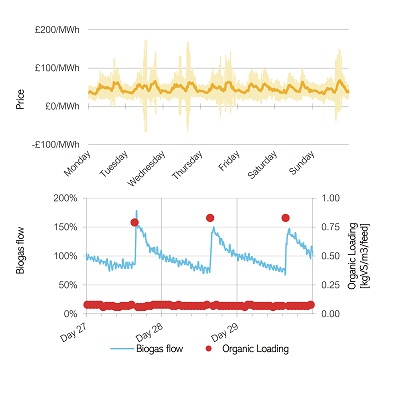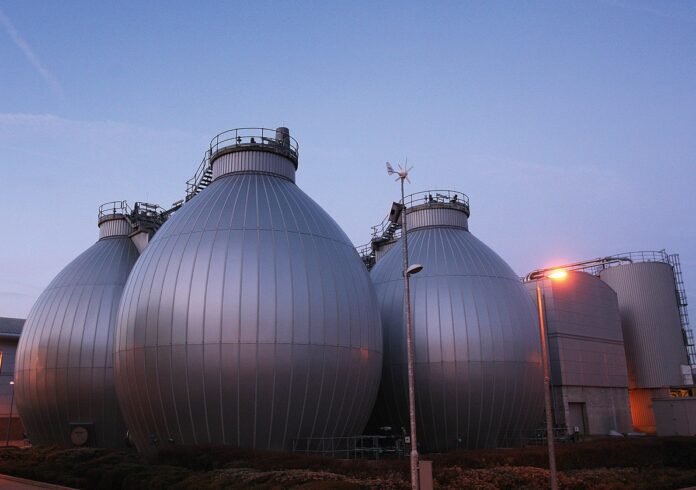A partnership between Thames Water Utilities and the University of Surrey in the UK is exploring innovative solutions for the best use of anaerobic digestion in a future decarbonised economy. By Mauro Lafratta, Eve Germain-Cripps and Rex B Thorpe.
Anaerobic digestion (AD) is a sustainable solution for processing sewage sludge and is used in many wastewater treatment plants across the world. Energy and resources recovery are the main benefits associated with AD – the biogas produced is typically used on site for electricity generation and heat requirements. AD, therefore, represents a crucial way to increase resilience and reduce operational costs, in turn, ultimately, providing a better service to customers and the environment.
This contribution is illustrated by the case of Thames Water, the largest water and wastewater services provider in the UK. The utility treats, on average, 4.6 billion litres of domestic sewage per day from 15 million customers. The company also self-produced more than 313GWh of renewable electricity from sewage sludge in 2019/20. This was mainly used on site, with some of the power exported to the grid.
This means AD already makes an important contribution in the arena of electricity generation and climate change mitigation. Provision of water and wastewater services is energy-intense. The UK water industry alone constitutes around 3% of the national annual electricity consumption. It can also be carbon-intense if the energy is not from renewable sources. AD is a good way to access the renewable energy in what is essentially an inevitable by-product of wastewater treatment. It can, therefore, make a significant contribution to reducing the carbon impact of the water sector and its transition towards a decarbonised economy. Indeed, the UK water industry is committed to operational carbon neutrality by 2030, and anaerobic digestion is an important part of this strategy.
The need for flexible generation
Many countries are transitioning towards the decarbonisation of their electricity grid, with the goal of achieving a zero-carbon system within one generation. The International Renewable Energy Agency estimates that around 95% of global electricity should be produced from renewable sources by 2050 to meet the targets of the Paris Agreement on climate change. Importantly, these renewable sources will mainly be wind and solar, which are intermittent and weather-dependent sources that cannot, on their own, ensure there is enough generation to meet demand at all times. Therefore, other flexible sources will be needed to ensure there is enough supply to meet demand and avoid blackouts.
Illustrating this need, what had been the longest period of coal-free electricity generation on record in the UK was interrupted in mid-August this year, when the combination of several factors – including high temperatures, low wind speeds and planned maintenance – meant National Grid had to request a coal power station to restart.
Globally, flexible electricity generation is mostly provided by fossil fuelled (coal or natural gas) power stations. Traditionally, hydroelectricity (conventional dams, free flowing/run-of-river, or pumped storage) can provide some flexible active generation where geomorphological conditions allow. For the future, different technologies are of interest. Biomass and energy storage are seen as the future providers of flexibility, including the rising interest in batteries. When coupled with low-carbon generation sources, batteries allow importing of electricity when there is excess on the grid and then its release when needed.
Although the contribution of each technology is limited, and their whole life-cycle costs and impacts need to be assessed, a combination of all these technologies could support the balancing of demand and supply on the electricity market.
In the above scenario, can AD do more? Researchers and practitioners to date have generally shared the opinion that AD performs better if operated in a steady state. The question is whether the biogas from AD could make a greater sustainable contribution.
Researching dynamic anaerobic digestion operation
Operating AD in a steady state returns a steady flow of biogas. However, given that the electricity market needs flexible options, there is an economic and environmental opportunity if AD can produce biogas dynamically and support flexible electricity generation. By generating more at ‘peak time’, the economic value of the biogas increases. At the same time, flexible electricity generation from a renewable source should reduce the grid’s ‘carbon intensity’ (the greenhouse gas emissions from the generation, usually expressed as CO2 equivalent per kWh generated), which is currently particularly high when flexible generation is needed.
Given this potential opportunity, the performance of the AD process, the potential to make this flexible (flexibilisation), and the benefits of using the biogas from AD of sewage sludge as a provider of flexible generation from a renewable source have been investigated as part of an engineering doctorate project.
The main research outcomes are briefly set out in the boxed text, and the application at different scales of dynamic biogas production will be presented at the IWA World Water Congress & Exhibition in Copenhagen. The work demonstrates the potential to feed and operate digesters dynamically, better connecting it with future energy needs.
Anaerobic digestion of the future
AD is a mature and well-established process, used globally to recover energy from sewage sludge for use in onsite operations. For the long term, there is considerable interest in the industry in exploring commercial opportunities to use AD as a process to produce specific materials and recover highly valuable resources. Meanwhile, wastewater treatment remains an energy-intense service that justifies using AD mainly for electricity self-generation. However, the needs of the electricity grid that have driven the widespread uptake of AD are changing. Therefore, it is becoming clear that we are transitioning towards a new era for this technology.
The innovation of this project lies in the fundamental concepts of how a sewage sludge treatment centre is designed and operated. This project suggests a smarter use of this technology, repurposing its primary use for a more beneficial scope for society, while retaining operational resiliency and security in a fundamental, but energy-intense, sector.
The assets are normally designed with the sole aim of treating the sewage sludge. This, in turn, means designs are based on average daily throughput to operate the assets with a constant flow, which produces baseload energy.
This project, in contrast, demonstrates that there is value in optimising the use of a large existing asset base. While an initial level of flexibilisation can be achieved with little or no capital investment by using existing biogas storage and combined heat and power generators, dynamic control of AD can reduce the need for biogas storage, support the whole generation system, and optimise the use of each process. A fully flexible sewage sludge-to-electricity system could be appropriately designed to add operational resilience to the system and ensure self-sufficiency and/or exporting to the grid at peak time.
Conclusions
This research introduces an innovative criterion to be added to the primary criteria of treating the sewage, covering how a sewage sludge treatment centre might be designed and operated: flexible energy management.
The main innovation of this project is in doing things differently: while AD is normally operated at steady state, this project suggests that dynamic control of the process has the potential to provide an additional service of supporting flexible electricity generation. As such, a flexible electricity generation strategy can be applied to every centralised urban wastewater treatment plant in the world that has, or will have, anaerobic digestion and electricity generation. Going beyond this, retrofitting and new designs offer the opportunity to optimise the assets for flexibility.
For a water and sewage company, this can result in an increase in financial and operational resilience, and reduction in the carbon emissions of operations. Additionally, the benefits of flexible electricity generation from AD-derived biogas extend beyond the water industry, and this operational solution can contribute towards unlocking a fully decarbonised electricity grid at national level.
Researching the viability of AD for flexible electricity generation
In the UK, the intra-day variability of the electricity market is significant. The research project started by observing and understanding how anaerobic digestion (AD) could match that variability. By appropriately designing the AD process feeding regimes according to the variable price of electricity and its carbon intensity, it is possible to obtain a dynamic biogas production that can support intra-day flexible electricity generation.
Pilot scale (50 litre active volume) experimental activities investigated the level of flexibilisation that AD could provide, both in conventional digestion (fed with a blend of primary and surplus activated sludges) and advanced digestion (fed with a similar blend, pre-treated using thermal hydrolysis). Advanced digestion provided a faster response and a clearer effect on the biogas production, but, in both cases, the analysis showed that dynamic operation provides a higher economic value for the biogas compared with a steady operational regime. The value can increase by up to 5% in conventional digestion and up to 7% in advanced digestion.
As the electricity is produced from a renewable source, there is an associated reduction in national carbon impact by replacing fossil fuelled flexible generation: just by using current assets differently, the UK water industry could reduce the national carbon intensity by 1.2gCO₂eq/kWh, or 0.5%.
Demonstration scale (18m3 active volume) trials raised the technology readiness by confirming the suitability of dynamic AD operations in conditions very similar to those at full scale. The value of the electricity generated from the biogas also increases in this realistic operational scenario. Performance and stability were not negatively affected; however, a small transitional imbalance in digester ‘health’ after the peak feed was observed.
As a result of this work, including final trials at full scale, this operational solution is now implemented at a wastewater treatment plant serving about 400,000 customers.
For more information: M Lafratta, RB Thorpe, SK Ouki, A Shana, E Germain, M Willcocks, J Lee, 2020, Dynamic biogas production from anaerobic digestion of sewage sludge for on-demand electricity generation, Bioresource Technology 310, doi.org/10.1016/j.biortech.2020.123415.

Figure 1. Electricity market prices (top) as average (yellow) and volatility (light yellow). ‘Peak times’ normally occur in the morning and in the afternoon (between 4pm and 8pm). The graph (bottom) reports data from the demonstration scale trials, where the schedule of organic loading feeding (red) is appropriately calculated to have a biogas flow (blue) matching the ‘afternoon peaks’ of the market.
Acknowledgement
The invaluable contributions of Dr Sabeha Ouki, Dr Jacquetta Lee, Dr Achame Shana and Mark Willcocks in co-supervising the research project are kindly acknowledged.
The authors
Mauro Lafratta is a Doctoral Practitioner in Sustainability at the University of Surrey and Thames Water, with the support of the UK Engineering and Physical Sciences Research Council. Dr Eve Germain-Cripps is Head of Process Engineering at Thames Water Utilities. Professor Rex B Thorpe is Professor of Chemical Engineering at the University of Surrey.








